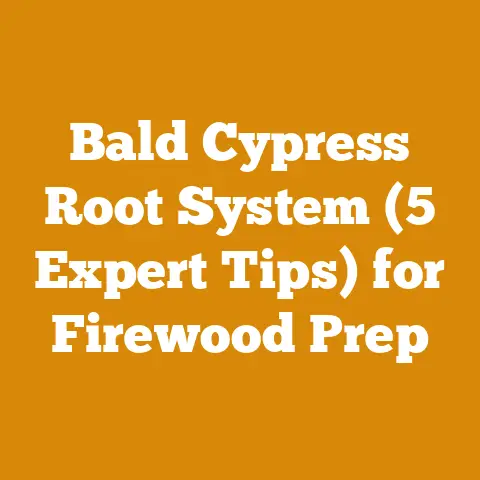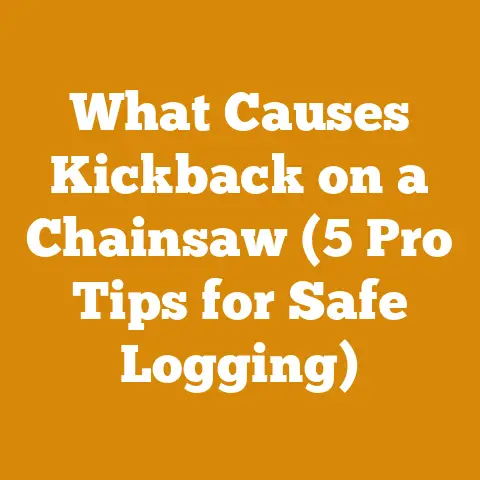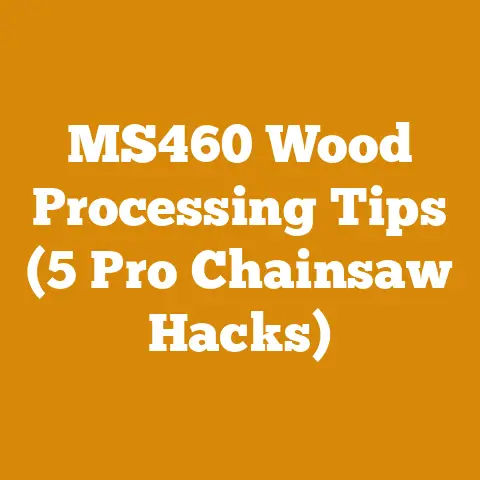7lb Brisket Cook Time (5 Smokewood Tips for Perfect Flavor)
The aroma of smoldering hickory, a gentle breeze rustling through the oak trees in my backyard, and the anticipation of a perfectly smoked brisket – these are the simple joys that make a weekend complete.
But, let’s be honest, the path to brisket nirvana isn’t always smooth.
It requires patience, skill, and, most importantly, understanding the nuances of cook time and the art of flavor infusion.
Today, we’re diving deep into the world of smoking a 7lb brisket, focusing on cook times and exploring five smokewood tips that will elevate your brisket from good to unforgettable.
7lb Brisket Cook Time (5 Smokewood Tips for Perfect Flavor)
Smoking a brisket is a journey, not a race.
It’s about understanding the meat, respecting the process, and embracing the unpredictable nature of fire.
This guide is designed to provide you with the knowledge and confidence to tackle that 7lb brisket and achieve mouthwatering results.
Understanding the 7lb Brisket: A Primer
Before we even think about cook time, let’s break down what we’re dealing with.
A 7lb brisket is likely a smaller packer brisket (the whole brisket, consisting of the point and the flat) or just a brisket flat.
The size dictates the cook time, but the fat content and thickness are equally crucial.
- The Flat: This is the leaner part of the brisket, prone to drying out if not cooked properly.
- The Point (Deckle): This is the fattier, more flavorful part, perfect for burnt ends.
The goal is to render the fat, break down the connective tissue (collagen), and create a tender, juicy, and smoky masterpiece.
Estimating the Elusive Cook Time: The Science and the Art
There’s no magic formula for brisket cook time, but a good rule of thumb is to estimate 1.5 to 2 hours per pound at a smoking temperature of 225-250°F (107-121°C).
This means a 7lb brisket can take anywhere from 10.5 to 14 hours.
However, this is just a starting point. Several factors influence the actual cook time:
- Smoker Temperature: Fluctuations in temperature can significantly impact cook time.
A consistent temperature is key. - Brisket Thickness: A thicker brisket will naturally take longer to cook.
- Fat Content: Higher fat content can slow down the cooking process.
- The Stall: This is a notorious phenomenon where the brisket’s internal temperature plateaus for several hours, typically between 150-170°F (66-77°C).
This is due to evaporative cooling. - Wrapping: Wrapping the brisket in butcher paper (the “Texas Crutch”) or foil can help push through the stall and speed up the cooking process.
My Personal Experience: I’ve smoked countless briskets, and I can tell you that no two are ever exactly the same.
I once had a 6lb brisket flat take 15 hours due to a stubborn stall, while another 8lb brisket finished in just 11 hours.
The key is to monitor the internal temperature and feel for tenderness.
The Importance of Internal Temperature
Forget about time.
The true indicator of brisket doneness is internal temperature.
Aim for an internal temperature of 203°F (95°C) in the thickest part of the flat.
However, temperature alone isn’t enough. The “probe tender” test is crucial.
When you insert a probe (like a thermometer or even a skewer) into the brisket, it should slide in with little to no resistance, like poking softened butter.
Tools You’ll Need:
- Reliable Thermometer: A digital thermometer with a probe is essential.
I recommend a leave-in probe thermometer that allows you to monitor the temperature without opening the smoker. - Instant-Read Thermometer: This is useful for spot-checking temperatures in different areas of the brisket.
Smokewood Tip #1: Choosing the Right Wood – A Flavor Foundation
The type of wood you use has a profound impact on the brisket’s flavor.
Here’s a breakdown of popular choices:
- Oak: A classic choice for brisket, providing a moderate, balanced smoky flavor.
It’s a versatile wood that complements beef well. - Hickory: Stronger than oak, hickory imparts a bolder, bacon-like flavor.
Use it sparingly, especially if you’re new to smoking. - Mesquite: This is a powerful wood with a distinct, earthy flavor.
It can be overpowering if used excessively.
I recommend using it in combination with oak or hickory. - Pecan: A milder, nuttier flavor that’s a good alternative to oak.
- Fruit Woods (Apple, Cherry): These woods provide a sweeter, more subtle smoky flavor.
They’re often used in combination with other woods.
My Preference: I personally prefer a blend of oak and hickory for my briskets.
I find that this combination provides a balanced smoky flavor that doesn’t overpower the beef.
Cost Considerations: The cost of smokewood varies depending on location, type of wood, and quantity purchased.
Here’s a rough estimate of costs per cord (a stack of wood 4 feet high, 4 feet wide, and 8 feet long):
Important Note: These are just averages.
Prices can fluctuate significantly based on local market conditions.
I always recommend checking with local firewood suppliers for the most accurate pricing.
I always try to buy in bulk during the off-season to save money.
Sustainability Tip: Consider sourcing your wood from sustainable sources.
Look for suppliers who practice responsible forestry management.
Smokewood Tip #2: Size Matters – Chunks vs. Chips vs. Sawdust
The form of your smokewood also affects the flavor and burn rate.
- Chunks: These are larger pieces of wood that burn slowly and provide a consistent smoke.
They’re ideal for long smokes like brisket. - Chips: Smaller pieces of wood that burn quickly and produce a lot of smoke.
They’re better suited for shorter smokes. - Sawdust: Very fine wood particles that smolder and produce a lot of smoke.
They’re often used in smoke generators or for cold smoking.
For brisket, I strongly recommend using chunks. They provide a more consistent and controlled smoke flavor.
I usually use 3-4 fist-sized chunks of wood for a 7lb brisket.
Cost Comparison:
- Smokewood Chunks: Typically sold in bags ranging from 5-10 lbs.
Prices range from $10-$25 per bag, depending on the wood type and brand. - Smokewood Chips: Generally cheaper than chunks, with prices ranging from $5-$15 per bag.
- Sawdust: Often sold in larger quantities and can be relatively inexpensive, especially if you can source it from a local woodworker.
My Pro Tip: Soak your wood chunks in water for at least 30 minutes before adding them to the smoker.
This will help them smolder and produce a cleaner smoke.
Smokewood Tip #3: Placement is Key – Optimizing Smoke Flow
Where you place the wood in your smoker is crucial for even smoke distribution.
- Charcoal Smokers: Place the wood chunks directly on top of the lit charcoal.
- Gas Smokers: Use a smoker box or wrap the wood chunks in foil with a few holes poked in it.
Place the box or foil packet directly on the burner. - Electric Smokers: Follow the manufacturer’s instructions for adding wood chips or chunks.
Important Considerations:
- Airflow: Ensure that the smoke can circulate freely around the brisket.
Don’t overcrowd the smoker. - Proximity to Heat Source: Avoid placing the wood directly on the hottest part of the heat source.
This can cause it to burn too quickly and produce acrid smoke.
My Setup: I use a charcoal smoker, and I like to create a “snake” of charcoal around the perimeter of the firebox.
I place the wood chunks on top of the charcoal snake, which allows for a slow and consistent burn.
Smokewood Tip #4: Smoke Intensity – Less is Often More
It’s tempting to load up your smoker with wood, but too much smoke can ruin your brisket.
Over-smoking can result in a bitter, acrid flavor.
The Sweet Spot: Aim for a thin, blue smoke.
This indicates that the wood is burning cleanly and producing a desirable flavor.
Thick, white smoke is a sign of incomplete combustion and can impart a harsh flavor.
Duration: You only need to smoke the brisket for the first few hours of the cook.
After the brisket reaches an internal temperature of around 140°F (60°C), it will no longer absorb much smoke.
At this point, you can remove the wood from the smoker.
My Rule of Thumb: I typically smoke my briskets for the first 4-6 hours, then wrap them in butcher paper and finish cooking them in the smoker until they reach the desired internal temperature.
Smokewood Tip #5: Experimentation is Encouraged – Find Your Signature Flavor
Don’t be afraid to experiment with different wood combinations and smoking techniques.
The best way to find your signature flavor is to try different things and see what works best for you.
Some Ideas to Try:
- Wood Blends: Combine different types of wood to create unique flavor profiles.
For example, try mixing oak with cherry or hickory with pecan. - Smoking Woods with Herbs: Add fresh herbs like rosemary or thyme to your smoker for an extra layer of flavor.
- Soaking Woods in Different Liquids: Soak your wood chunks in beer, wine, or apple cider for a unique twist.
My Experimentation Story: I once soaked some pecan wood chunks in bourbon before smoking a brisket.
The result was a surprisingly delicious and complex flavor that everyone raved about.
Budgeting for Brisket Bliss: A Cost Breakdown
Let’s talk about the financial side of things.
Smoking a brisket can be a relatively expensive endeavor, but with careful planning and budgeting, you can enjoy delicious smoked brisket without breaking the bank.
Cost Components:
- Brisket: The cost of brisket varies depending on the cut (packer vs.
flat), grade (choice vs.
prime), and location.
Expect to pay anywhere from $3-$8 per pound.
For a 7lb brisket, that’s $21-$56. - Smokewood: As mentioned earlier, the cost of smokewood varies depending on the type of wood and quantity purchased.
Budget $10-$25 for a bag of wood chunks. - Charcoal/Fuel: The cost of charcoal or other fuel depends on the type of smoker you’re using.
A bag of charcoal can cost anywhere from $15-$30.
Propane tanks for gas smokers typically cost $20-$30 to refill. - Rub and Seasonings: These costs are relatively minimal, but budget $5-$10 for your favorite rub and seasonings.
- Butcher Paper/Foil: If you plan to wrap your brisket, budget $5-$10 for butcher paper or foil.
- Electricity/Gas: If you’re using an electric or gas smoker, factor in the cost of electricity or gas.
This cost is typically minimal. - Time: Don’t forget to factor in the cost of your time!
Smoking a brisket is a labor of love, and it requires several hours of your attention.
Total Estimated Cost: $66 – $151 + Time
Cost Optimization Tips:
- Buy Brisket in Bulk: If you plan to smoke brisket regularly, consider buying it in bulk from a butcher or online retailer.
This can save you money in the long run. - Source Smokewood Locally: Look for local firewood suppliers to save money on smokewood.
- Use Coupons and Discounts: Keep an eye out for coupons and discounts on charcoal, rubs, and other smoking supplies.
- Batch Cooking: Smoke multiple briskets at once and freeze the leftovers.
This will save you time and fuel in the future. - DIY Rubs: Make your own rubs and seasonings using spices you already have in your pantry.
My Budgeting Strategy: I typically set aside $100-$150 for each brisket smoking session.
This allows me to buy high-quality brisket, smokewood, and other supplies without feeling like I’m overspending.
I also try to plan my smoking sessions around sales and discounts.
Troubleshooting Brisket Blunders: Common Issues and Solutions
Even with the best planning and preparation, things can sometimes go wrong.
Here are some common brisket smoking issues and how to fix them:
- Dry Brisket: This is often caused by overcooking or not wrapping the brisket.
To prevent dry brisket, monitor the internal temperature carefully and wrap the brisket in butcher paper when it reaches an internal temperature of around 160°F (71°C). - Tough Brisket: This is usually caused by undercooking or not allowing the brisket to rest long enough.
To ensure a tender brisket, cook it until it reaches an internal temperature of 203°F (95°C) and let it rest for at least an hour before slicing. - Bitter/Acrid Flavor: This is typically caused by over-smoking or using the wrong type of wood.
Use a moderate amount of wood and choose a wood that complements beef well. - Stall: This is a common phenomenon where the brisket’s internal temperature plateaus for several hours.
To push through the stall, wrap the brisket in butcher paper or foil. - Uneven Cooking: This can be caused by uneven heat distribution in your smoker.
Rotate the brisket occasionally to ensure even cooking.
My Troubleshooting Experience: I once had a brisket stall for over 6 hours!
I was starting to panic, but I decided to stay patient and continue monitoring the temperature.
Eventually, the brisket started to climb again, and it turned out perfectly.
The key is to not give up and trust the process.
The Art of Slicing: Presentation Matters
Once the brisket is cooked and rested, it’s time to slice it.
This is a crucial step that can make or break your brisket.
The Technique:
- Identify the Grain: The first step is to identify the direction of the grain.
This is the direction that the muscle fibers run. - Slice Against the Grain: Always slice against the grain.
This will shorten the muscle fibers and make the brisket more tender. - Thickness: Aim for slices that are about 1/4 inch thick.
- Sharp Knife: Use a sharp knife to slice the brisket.
A dull knife will tear the meat and make it less appealing.
My Slicing Secret: I like to use a long, slicing knife with a serrated edge.
This helps me cut through the brisket cleanly and easily.
Beyond the Brisket: Utilizing Leftovers
Even a 7lb brisket can yield a lot of leftovers.
Don’t let them go to waste!
Here are some creative ways to use leftover brisket:
- Brisket Tacos: Shred the brisket and use it as a filling for tacos.
- Brisket Sandwiches: Pile the brisket high on a bun with your favorite toppings.
- Brisket Chili: Add the brisket to your favorite chili recipe.
- Brisket Hash: Dice the brisket and mix it with potatoes, onions, and peppers for a hearty hash.
- Brisket Mac and Cheese: Stir the brisket into your favorite mac and cheese recipe.
My Leftover Hack: I love making brisket grilled cheese sandwiches.
They’re quick, easy, and incredibly delicious.
Final Thoughts: Embracing the Brisket Journey
Smoking a brisket is a challenging but rewarding experience.
It requires patience, skill, and a willingness to learn from your mistakes.
Don’t be discouraged if your first few briskets aren’t perfect.
Keep practicing, experimenting, and refining your technique.
With time and effort, you’ll be able to consistently produce mouthwatering brisket that will impress your friends and family.
Remember, the journey is just as important as the destination.
Enjoy the process of smoking, savor the aroma of the wood, and embrace the unpredictable nature of fire.
And most importantly, have fun!
Now go forth and conquer that 7lb brisket!
May your smoke be thin and blue, and your brisket be tender and juicy.
Happy smoking!






